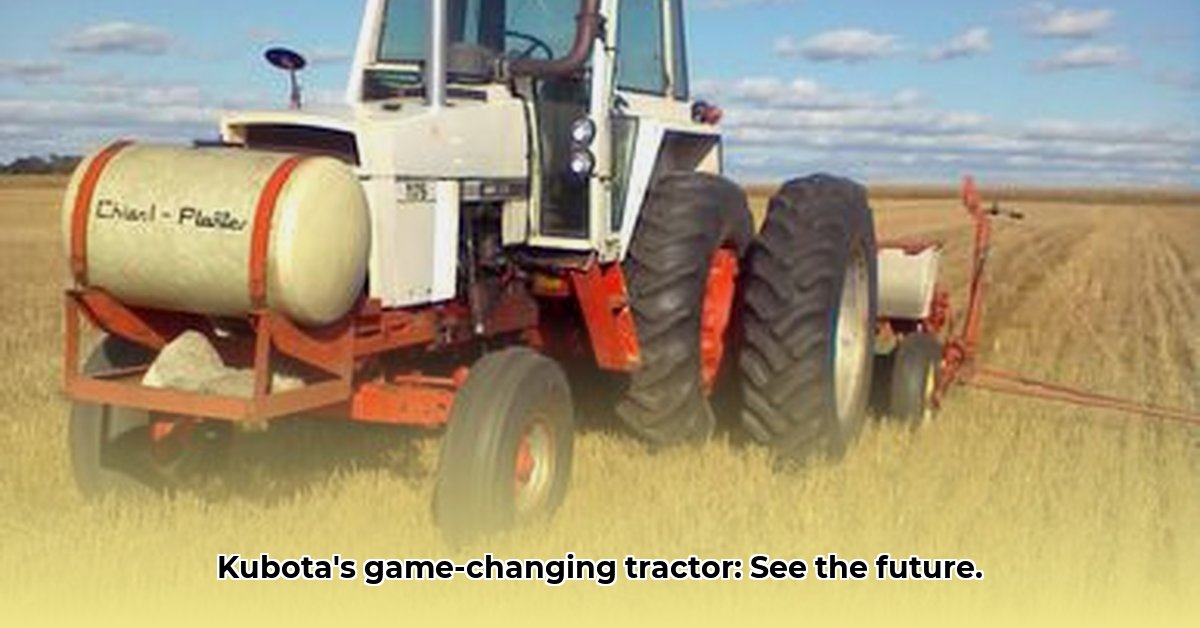
A Self-Driving Revolution: More Than Just Automation
Kubota's "Dream Tractor" marks a pivotal moment in agricultural technology. It's not merely automation; it's a holistic transformation of farming practices, addressing critical challenges like an aging farming population, labor shortages, and the urgent need for sustainable food production. This intelligent machine, building on Kubota's AGRIROBO series, leverages AI, electric power, and an adaptable chassis design to streamline operations and minimize environmental impact. How will this impact the future of food production? Only time will tell, but the potential is immense. Already, the tractor's efficiency promises cost savings and potentially higher yields, a boon for farmers worldwide. For more information on Kubota equipment, check out Kubota serial numbers.
The Tech Behind the Dream: Power and Precision
The Dream Tractor's technical prowess is undeniable. Its autonomous operation relies on sophisticated AI algorithms for navigation, task performance (planting, harvesting), and adaptive responses to changing conditions. Its fully electric powertrain, combining high-capacity lithium-ion batteries and solar panels, signifies a significant step toward eco-friendly farming. The unique four-wheeled crawler chassis ensures exceptional maneuverability across diverse terrains. Data integration into farm management systems provides real-time insights into crop health, soil conditions, and overall farm efficiency. But challenges remain. The unpredictability of weather and crop variability necessitate ongoing AI refinement to handle unexpected situations. Furthermore, the integration of advanced technology introduces inherent cybersecurity risks, requiring robust protective measures to ensure data security and operational reliability. What new innovations will overcome these hurdles? Further research and development will be critical.
Societal Impact: Opportunities and Concerns
The Dream Tractor's societal impact is multifaceted. It offers a potential solution to the shrinking agricultural workforce, particularly in regions facing labor shortages due to an aging population. However, the transition to automation raises crucial concerns about job displacement. Proactive measures – worker retraining and creation of new job categories related to technology management and maintenance – are vital to mitigate potential negative consequences. We need to carefully consider how our workforce adapts to this new technological landscape. What societal adjustments are needed to ensure a just transition? This is a discussion that must involve farmers, policymakers, and technology developers alike.
Economic and Regulatory Considerations: The Path to Market
The Dream Tractor's economic viability depends on several factors. The high initial purchase price could limit accessibility for smaller farms, necessitating a thorough cost-benefit analysis. Long-term maintenance and battery replacements add to the overall cost. Increased yields and reduced labor costs must outweigh these expenses. Furthermore, navigating the regulatory landscape is crucial. Clear guidelines on safety standards, data privacy, and environmentally responsible disposal of electric components are essential for fostering innovation while addressing potential risks. What incentives will encourage wide-scale adoption? Government policies must support both innovation and responsible use of this new technology.
The Future of Farming: A Collaborative Effort
The future of autonomous farming hinges on collaboration. Kubota's ongoing R&D should focus on AI refinement, battery technology improvements, and enhanced chassis adaptability. Robust cybersecurity remains a paramount concern, requiring continuous investment and improvement. Regulatory bodies must provide clear, comprehensive guidelines. Farmers’ participation in pilot programs is critical for real-world feedback. This collective effort – uniting technology developers, policymakers, and the agricultural industry – is crucial for successfully integrating this technology. What will the next generation of autonomous farming look like? This future depends on coordinated action and a shared vision.
Actionable Steps and Mitigating Potential Risks
The following table outlines key actions for navigating the challenges and maximizing the potential of Kubota's Dream Tractor:
| Stakeholder | Short-Term Actions | Long-Term Strategies |
|---|---|---|
| Kubota R&D | Enhance AI, improve battery technology, reinforce cybersecurity. | Develop commercialization strategy; ensure regulatory compliance. |
| Farmers | Participate in pilot projects; provide feedback; assess suitability. | Gradual adoption, integrating autonomous tech as it matures. |
| Government Agencies | Establish clear safety and data privacy regulations; promote sustainable farming. | Fund R&D provide incentives for eco-friendly technologies. |
| Technology Providers | Develop advanced AI and data analytics; prioritize cybersecurity solutions. | Collaborate with equipment manufacturers; create integrated smart farming solutions. |
This collaborative approach is vital for a successful transition. Strategic planning, mitigating potential risks, and maximizing benefits will define the success of this agricultural revolution.
How to Mitigate Cybersecurity Risks in Autonomous Farm Equipment
Autonomous farm equipment introduces significant cybersecurity vulnerabilities. Protecting against data breaches, denial-of-service attacks, and other threats requires a robust, multi-layered approach. What security measures are truly effective? A detailed examination of current vulnerabilities and the development of comprehensive security protocols is essential.
Understanding the Threat Landscape
The interconnected nature of modern farm equipment expands the attack surface, including IoT sensors, drones (UAVs), and cloud services. Data breaches can expose sensitive information, while denial-of-service attacks can cripple operations. Even blockchain technology isn't immune to vulnerabilities. How can we adequately protect against these diverse threats? A comprehensive understanding of the vulnerabilities is the first step in building an effective defense.
Practical Steps for Mitigation
Mitigating cybersecurity risks in autonomous farm equipment requires proactive measures:
- Strong Passwords and Updates: Use strong, unique passwords and regularly update software/firmware.
- Secure Communication: Ensure encrypted communication channels (HTTPS, TLS).
- Access Control: Limit access to authorized personnel; implement MFA.
- Regular Security Audits: Conduct regular audits to identify vulnerabilities.
- Employee Training: Educate employees about cybersecurity threats.
- Invest in Security Solutions: Utilize tailored cybersecurity solutions for the agricultural sector.
- Data Backup and Recovery: Regularly back up data to a secure, offsite location.
- Collaboration: Share best practices and information with other stakeholders.
Long-Term Strategies
Long-term planning is crucial. This includes establishing strong cybersecurity policies, advocating for government support for agricultural cybersecurity research, and developing sector-specific security standards. How can we adapt to the constantly evolving threat landscape? This requires constant vigilance and improvement.
The Future of Farm Cybersecurity
The future of farming demands secure, reliable technology. By investing in proactive security measures and fostering collaboration, we can build a future where technology drives progress without compromising security.